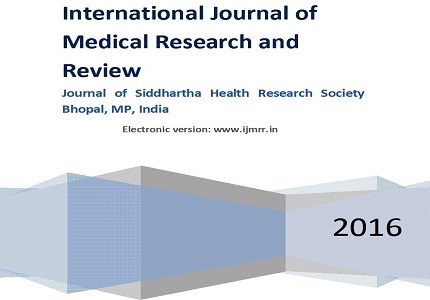Study of clinical risk factors for vitreous haemorrhage
Abstract
Background: Vitreous haemorrhage is one of the common causes of visual loss and it is due to number of risk factors. This study aims to establish an early etiology of vitreous haemorrhage in our environment which provides proper treatment to help in early absorption and prevention of complications so as to avoid irreversible damage to sight.
Methods: A 20 months retrospective review of medical records of patients who admitted in the department of ophthalmology, Gandhi Medical College and associated Hamidia Hospital, Bhopal with vitreous haemorrhage between from April 2010 to December 2011. Demographic data, etiological factors of vitreous haemorrhage and involved eye were amongst the information culled from the records and analysed.
Results: Seventy five patients were seen over the period under review out of which 78% they were males. The age range was 16-45 years. Vascular disorders (48%) and trauma accounted for 29.33% of all the causes of vitreous haemorrhage.
Conclusion: vascular disorder is a significant cause of vitreous haemorrhage in our environment affecting the all age group and while considering individual aetiological factors the ocular trauma showed highest incidence. The poor presenting visual acuity reflects the severity of causes of vitreous haemorrhage. Awareness needs to be increased to assess the causes and risk factors of vitreous haemorrhage.
Downloads
References
2. Lean JS, Gregor Z. The acute vitreous haemorrhage. Br J Ophthalmol. 1980 Jul;64(7):469-71.
3. Morse PH, Aminlari A, Scheie HG. Spontaneous vitreous hemorrhage. Arch Ophthalmol. 1974 Oct;92(4):297-8.
4. Jampol LM, Ebroon DA, Goldbaum MH. Peripheral proliferative retinopathies: an update on angiogenesis, etiologies and management. Surv Ophthalmol. 1994 May-Jun;38(6):519-40.
5. Kumar D, Saxena RC, Saxena S. Vitreous haemorrhage in Eales' disease. Afro-Asian J Ophthalmol 1995; 13: 19-22.
6. Dana MR, Werner MS, Viana MA, Shapiro MJ. Spontaneous and traumatic vitreous hemorrhage. Ophthalmology. 1993 Sep;100(9):1377-83.
7. Rotimi-Samuel A, Aribaba OT, Mbadugha CA, Ilo AO, Onakoya AO, , Akinsola FB, Adefule-Ositelu AO . Etiology of Vitreous Haemorrhage in Guinness Eye
Centre, Lagos University Teaching Hospital over a Two Year Period (June 2007-May 2009).Nig Q J Hosp. Med 2010; 20(4): 162-164.
8. Chang TS, Aylward GW, Davis JL, Mieler WF, Oliver GL, Maberley AL, Gass JD. Idiopathic retinal vasculitis, aneurysms, and neuro-retinitis.Retinal Vasculitis Study. Ophthalmology. 1995 Jul;102(7):1089-97.
9. Sarrafizadeh R, Hassan TS, Ruby AJ, Williams GA, Garretson BR, Capone A Jr, Trese MT, Margherio RR. Incidence of retinal detachment and visual outcome in eyes presenting with posterior vitreous separation and dense fundus-obscuring vitreous haemorrhage. Ophthalmology 2001; 108 (12): 2273-78.
10. Ogawa T, Kitaoka T, Dake Y, Amemiya T. Terson syndrome: a case report suggesting the mechanism of vitreous hemorrhage. Ophthalmology. 2001 Sep;108(9):1654-6.



 OAI - Open Archives Initiative
OAI - Open Archives Initiative


